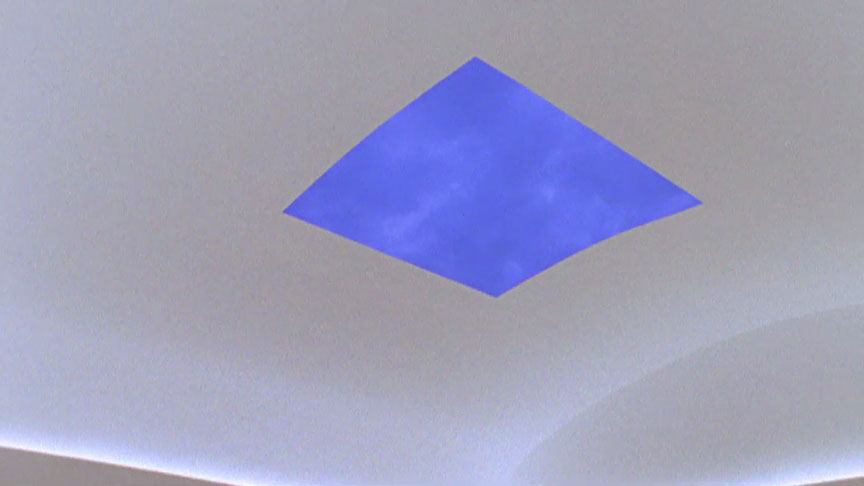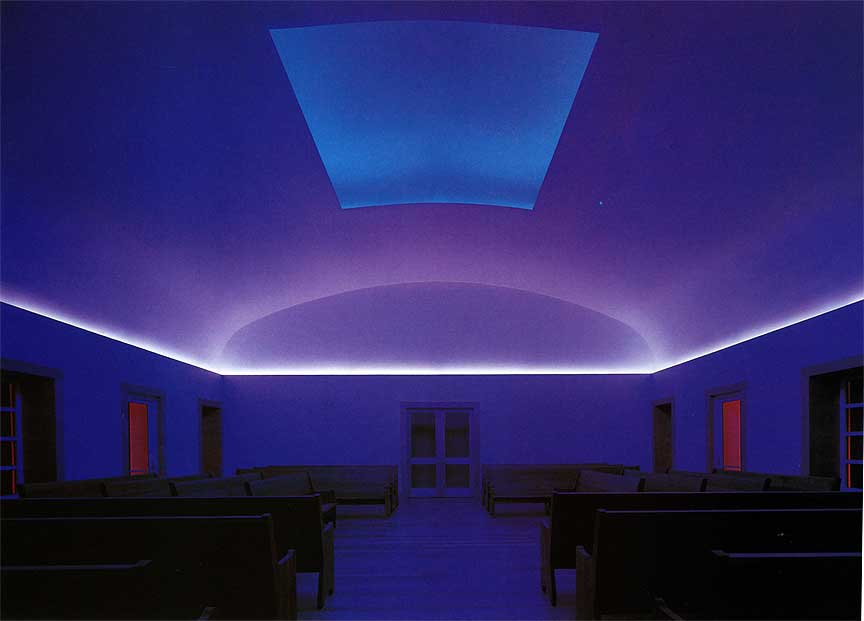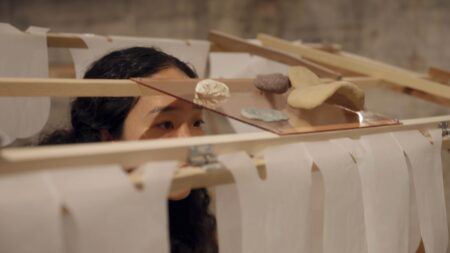Interview
“Live Oak Friends Meeting House”

Live Oak Friends Meeting House, Houston, Texas, 2000. Production still from the Art in the Twenty-First Century Season 1 episode, Spirituality, 2001. © Art21, Inc. 2001.
James Turrell discusses his 2001 design for a Quaker meetinghouse in Houston.
ART21: How did you come to design the Quaker meetinghouse in Houston? Was that your idea, or did the Friends there contact you?
TURRELL: First of all, the meetinghouse in Houston really was, in the beginning, the idea of Hiram Butler, who is a gallerist in Houston. He became very interested in the different projects regarding art and religion in Houston. The Rothko Chapel is probably the best example that is known. And also, he was thinking about the making of stained glass windows in the Episcopal church. Perhaps he was wanting to get Richard Serra to do a synagogue.
He’d become interested in Quakers at the time, and there was a Meeting that was without any meetinghouse. The Live Oak Friends Meeting in Houston was meeting in a dance studio until they made a meetinghouse. And they had a location picked out, but they really didn’t have the funding for this. So, he thought it would be a good idea to make this similar to the Rothko Chapel, so that donors could come from outside, particularly from the art world. And that’s what he proceeded to do: to get a situation where donations were given largely from the art community, and also from the Meeting as well, for the building of this meetinghouse. He did this by asking me to be involved in the design of the meetinghouse and, in particular, put some kind of work in the meetinghouse.
The piece I have at P.S.1 is called Meeting because of that interest. First of all, there’s this four-square seating that’s inside, seating toward each other—having a space that created some silence, allowing something to develop slowly over time, particularly at sunset. Also, this Meeting had to do with the meeting of the space that you’re in with the space of the sky. So, the sky’s no longer out there anymore, but it seems to be brought close in touch with you and [the] space where you sit.
ART21: What sort of dialogue did you have with the Friends, while working on the meetinghouse?
TURRELL: There was a dialogue about the meetinghouse and also the needs and the size, and those are the more important things to the portion I was involved with. Other things—materials and many things—came up, and they went through these things. And also Leslie Elkins, who was the architect, had some interesting parts, because Quaker decision making is by consensus. So, this is a rather slow process, purposefully so. And some people will think that Quakers are sort of the ultimate passive-aggressives, in that decision making can be nearly like procrastination.

Live Oak Friends Meeting House, Houston, Texas, 2000. Production still from the Art in the Twenty-First Century Season 1 episode, Spirituality, 2001. © Art21, Inc. 2001.
ART21: Growing up a Quaker . . . This meetinghouse must have had some special significance for you.
TURRELL: Well, for me that was kind of the meetinghouse I always wanted to see. I guess I like the literal quality or feeling or sensation, in that I want to feel light physically. We drink it as vitamin D; it’s actually a food. We are heliotropic. And it has a big effect on the skin; it produces vitamin D. We also have a big psychological relation to light. All or most spiritual experiences, near-death experiences, are described with a vocabulary of light. So, for me, this quality to feel light exists, almost like we see it in a dream. And in having this associated with the Meeting . . . First of all, it’s something that generally wouldn’t necessarily be opened with the Meeting, but it’s something that can give that quality, say in a midweek Meeting, or in the evening when you change from day to night. So, it was something I was very happy to do. It just took a lot to plan it.
ART21: How did the design of the building take shape, especially when it comes to the ceiling that is removable?
TURRELL: The Meeting is actually like the Gunpowder Meeting—or some of the earlier American Quaker Meetings, like at Easton, Maryland (or Third Haven), which is [from the] 1680s and one of the earliest structures that’s been in continuous use. Gunpowder Meeting—the long house form is something that was traditional, but it was mainly over here. That’s what I started with, as an idea. But then making this, in terms of the sizing and the use that was asked for by Live Oak Meeting—I mean, it’s a very traditional form, except it’s convertible. The top opens, and it makes a sky space where the sky is really brought down to you; your awareness of it is made quite different. Anyway, I suggested that, and it was a little bit of a novel idea, that it’s a roof that opens. But they were very interested to do this, and so in the end came up with this, and we started out with this fundraising. I think it was quite interesting.
ART21: How does the meaning of light relate to the Quaker tradition?
TURRELL: Well, George Fox talked about the light, both in a literal and a figurative sense, or allegorical sense. And a lot of it is the revelation—which is a light, as in a bright idea can light—but it always says this image of light. And so, I was very interested in this literal look at it—actually greeting this light that you find in meditation, and following that. But that’s not its entire meaning, and I think that that’s why I just express it that way. But it’s certainly something that I’ve related to and like.

James Turrell. Skyspace at Live Oak Friends Meeting House, Houston, Texas, 2000. Retracted skyspace shows light changing as sun sets. Photo by Joe Aker. Courtesy of the artist and Live Oak Friends.
ART21: Do you remember your first Meeting?
TURRELL: We had very early Meetings, or earlier Meetings. Some of them were longer than one hour. And so, it’s something for a child to be introduced to the Meeting. And there is this time, when you no longer are in First Day School but you actually come and join the Meeting. And my grandmother was trying to tell me what you did. So, her explanation to me was: you went inside to greet the light. And this idea—to go inside to find that light within, literally as well as figuratively—was something that really propelled me at the time. I really thought that that’s what I should do. Of course, I’m still trying to figure out exactly what she meant. But I like that quality.
You have to also remember that I fell away from all this—and for many years, nearly twenty-five years, had no interest whatsoever in this—but carried on this involvement with light. And again, talking about this idea of light—particularly the light not seen with the eyes—was very important. When you think of the dream—where does the light come from in the dream? Here is a way of seeing—with a richer color, greater lucidity of color, and certainly equal if not better clarity in some dreams—and you have your eyes completely closed. So, you ask yourself, “Is this just memory? Well, then, how do you explain this sort of déjà vu? Maybe this is memory, and the dream is the reality.” So, we have ways of thinking about reality, and a lot of what we’re doing is figuring out how we create our own reality, that we then live within. And that’s very interesting to me, about art—because art has a lot to do with this, changing our sense of reality.



